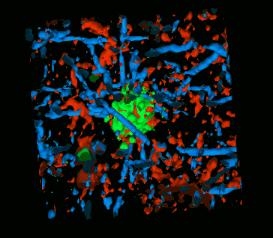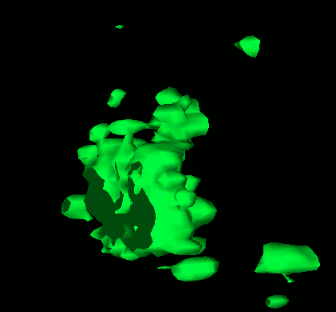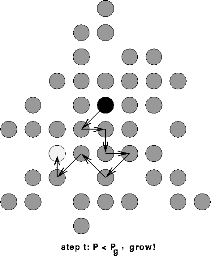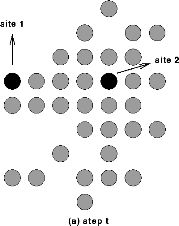

Luis Cruz
Center for Polymer Studies
Boston University
Alzheimer disease is a progressive neurodegenerative disorder of the central nervous system. The exact causes of the disease are unknown. The symptoms are familiar: loss of memory and other cognitive functions and eventually loss of control of bodily functions. The most obvious change in the brain of Alzheimer's disease patients is the loss of neurons. In addition, Alzheimer's victims have formations of senile plaques and neurofibrilary tangles, neither of which is present in normal brains.
In a collaborative research between physicists from the Center for Polymer Studies at Boston University and neurologists from the Massachusetts General Hospital, researchers are studying immunostained pictures of senile plaques, neuronal bodies, dendrites and tangles, taken by confocal microscope. The pictures are then analyzed using methods of statistical physics. The overall purpose of the research is to find out the mechanisms of the growth of senile plaques, to understand how the neuronal architecture is altered in the disease, and to quantify changes in the geometry of dendrites as compared to the dendrites in the cortex of healthy brains.
This video was created in real time on an Immersadesk VR system.
The three surfaces in the video are neurites (blue), amyloid
beta protein(red) and tau protein (green). Initially, only the neurites
are shown, and then the user chooses to turn up the opacity of
the amyloid beta and then the tau protein. Lastly, the plaque
(tau) is shown by itself displaying a porous surface.
3D reconstruction is performed on experimental and computer generated plaques. We attempt to analyze the internal porosity of experimental plaques and study the characteristic sizes of these internal pores.

The goal of this part of the project is to come up with a reasonable mathematical model that would describe the physical and geometrical properties of plaques in Alzheimer's disease based on very simple iterative rules.
The iterative rules are implemented on pixels that live on a discrete lattice. The outcome is a non-trivial "growth" that resembles in several ways the real plaques found in the brains of Alzheimer's disease patients. The rules are based on basic physical and biological mechanisms, such as the aggregation of Amyloid-Beta to form plaques and the response of the immune system to plaques.
There are two basic mechanisms for the growth of the model plaques, a growth and a cleaning mechanism. Correspondingly, there are two rules that achieve the growth and the clean. The growth is referred to as an aggregation rule (image on left) and the clean is referred to as a disaggregation rule (image on right)


A dynamic feedback mechanism is introduced in order to stabilize the number of pixels in the system. The feedback changes the disaggregation probability (leaving the aggregation probability unchanged) such that the total number of pixels is conserved on average over time.
Surface diffusion: After every timestep, an additional step rasters through every pixel and applies a test where the pixel is "moved" to a random vacant nearest neighbor and is kept there only if it turns out with greater number of nearest neighbors.
Back to the SCV Home Page